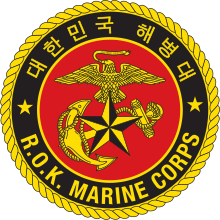ROKMC
| Republic of Korea Marine Corps 대한민국 해병대 Daehanminguk Haebyeongdae |
|
|---|---|

Seal of the Republic of Korea Marine Corps
|
|
| Active | April 15, 1949 – October 10, 1973 November 1, 1987 – present |
| Country |
|
| Type | Marine corps, naval infantry |
| Role | Amphibious warfare |
| Size | 29,000 (as of 2014) |
| Part of |
|
| Garrison/HQ | Hwaseong, Gyeonggi Province, South Korea |
| Nickname(s) |
무적 해병 (無敵海兵, Invincible Marines) 귀신잡는 해병대 (Marine Corps: The Devil Catchers) |
| Motto(s) |
한번 해병은 영원한 해병 (Once a Marine, Always a Marine) |
| Mascot(s) | Jindo Dog |
| Engagements |
Korean War Vietnam War Global War on Terrorism |
| Commanders | |
| Current commander |
LtGen Lee Sang-hoon, ROKMC |
| Insignia | |
| Flag |  |
The Republic of Korea Marine Corps (ROKMC; Korean: 대한민국 해병대; Hanja: 大韓民國海兵隊; Revised Romanization: Daehanminguk Haebyeongdae), also known as the ROK Marine Corps, or the ROK Marines, is the marine corps of South Korea. Though theoretically it is under the direction of the South Korean Republic of Korea Fleet Command, the ROK Marine Corps operates as a distinct arm of the South Korean Armed Forces, unlike the marine corps of most other countries, which generally operate as part of a navy. The ROKMC was founded as a suppression operations force against communist partisans just prior to the start of the Korean War. The ROKMC also saw combat during the Vietnam War, while stationed in Da Nang, occasionally fighting alongside the U.S. Marines.
On April 15, 1949, the Republic of Korea Marine Corps (ROKMC) was founded at Deoksan airfield in Jinhae with an initial strength of 380 men and was modeled around the United States Marine Corps. Lieutenant Colonel Shin Hyun-joon was appointed to lead as the first Commandant of the newly formed Marine Corps and he was promoted to Colonel on July 1, 1949. The ROKMC troops were issued with many secondhand weapons from the Imperial Japanese Army used during World War II, including the 7.7 mm Type 99 Light Machine Gun. The Marine Corps carried out suppression operations against communist elements in Jinju and Jeju-do. The ROKMC saw combat actions in the Korean War, including the Battle of Incheon.
...
Wikipedia
